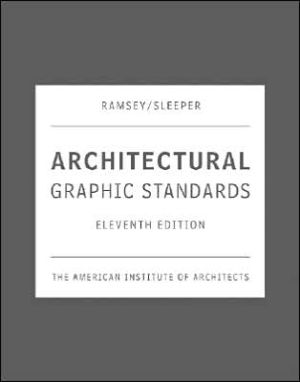Architectural Graphic Standards
Since 1932, the ten editions of Architectural Graphic Standards have been referred to as the "architect's bible." From site excavation to structures to roofs, this book is the first place to look when an architect is confronted with a question about building design. With more than 8,000 architectural illustrations, including both reference drawings and constructible architectural details, this book provides an easily accessible graphic reference for highly visual professionals.\ To celebrate...
Search in google:
Since 1932, the ten editions of Architectural Graphic Standards have been referred to as the "architect's bible." From site excavation to structures to roofs, this book is the first place to look when an architect is confronted with a question about building design. With more than 8,000 architectural illustrations, including both reference drawings and constructible architectural details, this book provides an easily accessible graphic reference for highly visual professionals. To celebrate seventy-five years as the cornerstone of an industry, this commemorative Eleventh Edition is the most thorough and significant revision of Architectural Graphic Standards in a generation. Substantially revised to be even more relevant to today's design professionals, it features: An entirely new, innovative look and design created by Bruce Mau Design that includes a modern page layout, bold second color, and new typeface Better organized— a completely new organization structure applies the UniFormat(r) classification system which organizes content by function rather than product or material Expanded and updated coverage of inclusive, universal, and accessible design strategies Environmentally-sensitive and sustainable design is presented and woven throughout including green materials, LEEDS standards, and recyclability A bold, contemporary new package—as impressive closed as it is open, the Eleventh Edition features a beveled metal plate set in a sleek, black cloth cover Ribbon Markers included as a convenient and helpful way to mark favorite and well used spots in the book All New material Thoroughlyreviewed and edited by hundreds of building science experts and experienced architects, all new details and content including: new structural technologies, building systems, and materials emphasis on sustainable construction, green materials, LEED standards, and recyclability expanded and updated coverage on inclusive, universal, and accessible design strategies computing technologies including Building Information Modeling (BIM) and CAD/CAM new information on regional and international variations accessibility requirements keyed throughout the text new standards for conducting, disseminating, and applying architectural research New and improved details With some 8,500 architectural illustrations, including both reference drawings and constructible architectural details, Architectural Graphic Standards continues to be the industry's leading, easily accessible graphic reference for highly visual professionals.Paul Glassman - Library JournalFirst published in 1932, this commemorative 75th edition of Architectural Graphic Standards(AGS)-more a professional handbook than a guide to graphic conventions-represents the most ambitious revision and overhaul in the publication's history. Over the years, its length has more than doubled; its drawings are now computergenerated rather than rendered by hand. Reorganized into three sections with a set of appendixes, this edition begins with building elements, continues with materials, and ends with issues in contemporary practice. Toward the back are entirely new chapters on sustainable design, computing technologies, and architectural research. As a result of a new CSI UniFormat™ classification system applied to the first chapter on building elements, practitioners may need to adjust considerably from the earlier 16division format. The emphasis on green design-e.g., LEED standards™ and recyclability-is welcome. Other innovations include data on building information modeling (BIM) and computerassisted design/computerassisted modeling (CAD/CAM) and an overhaul of the book's physical and graphic design: Bruce Mau Design based the structure of each page on the ninepart grid of the Abbey of St. Gaul, adding three ribbon markers and an embossed metal cover plate. But the page design is problematic in its overly small font size and wholly inadequate margins at the gutter, which makes photocopying nearly impossible. The accompanying CDROM, which allows details and drawings to be imported to CAD, is regrettably a separate purchase.
Publisher's Note. Foreword. Preface. Advisory Board. Subject Editors. Acknowledgments. Timeline. Introduction: Integrating Performance and Poetics. A New Generation of Architectural Graphic. Model Case Study: Genzyme. Situating Ramsey and Sleeper: A Genealogy of. A Short History of Detailing. SECTION 1: BUILDING ELEMENTS. 1. Element A. Substructure. Introduction. Soils and Soils Explorations. Soils Definitions, Terms And Classifications. Soil Studies And Reports. Geographic Variations. Climatic Foundation Issues. Seismic Foundation Issues. Foundations. General. Settlements and Differential Settlements. Standard Foundations. Shallow Foundations. Deep Foundations. Special Foundations. Foundations for Individual Building Types. Seismic Base Isolation. Underpinning and Foundation Reinforcing. Slab-On-Grade. Basement Construction. Basement Excavation. Basement Walls. Case Studies. 2. Element B. Shell. Introduction. General Information. Climate and Energy. Sustainability And Energy. Recommended Reading. Superstructure. Floor Construction. Roof Construction. Fireproofing and Firestopping. Exterior Enclosure. Exterior Walls. Exterior Windows. Doors. Roofing. Steep Slope Roofing. Low Slope Roofing. Drainage. Flashing. Roof and Parapet Expansion Joints. Skylights, Scuttles, And Vents. Roof Detailing. Case Studies. 3. Element C. Interiors. Introduction. Interior Construction. Partitions. Wall and CornerGuards. Interior Doors. Fireplaces and Stoves. Special Room Construction. Stairs. Concrete Stairs. Metal Stairs. Steel Stairs. Wood Stairs. Alternate Stair Types. Treads, Risers, and Nosings. Interior Finishes. Wall Finishes. Floor Finishes. Ceiling Finishes. Case studies. 4. Element D. Services. Introduction. Conveying. Design Considerations. Elevator Systems. Escalators and Moving Walks. Material Conveyors. Chutes and Dumbwaiters. Plumbing. Design Considerations. Plumbing Fixtures. Plumbing System Types. Plumbing System Pipes and Valves. Potable Water Distribution System. Sanitary and Waste Drainage Systems. Stormwater Drainage Systems. Typical Building Water and Gas Service. Other Plumbing Systems. Case studies. 5. Element E. Equipment and Furnishings. Introduction. Equipment. Commercial Equipment. Institutional Equipment. Vehicular Equipment. Other Equipment. Furnishings. Fixed Furnishings. Furniture and Accessories. Case studies. 6. Element F. Special Construction and Demolition. Introduction. Special Construction . Special Structures. Integrated Construction. Special Construction Systems. Special Facilities. Special Controls and Instrumentation. Selective Building Demolition. Building Elements Demolition. Hazardous Components Abatement. Case Studies. 7. Element G. Building Sitework. Introduction. Site Preparation. Embankment Stabilization. Site Improvement. Porous Pavements. Parking Lots. Pedestrian Paving. Site Development. Landscaping. Site Civil/Mechanical Utilities. Subsurface Drainage Systems. Surface Drainage Systems. Runoff Control Systems. Manholes, Inlets, and Catch Basins. Site Electrical Utilities. Site Lighting. Case Studies. SECTION 2: MATERIALS. 8. CONCRETE. Introduction. Concrete Forms and Accessories. Economy Of Concrete Formwork. Concrete Formwork for Columns And Footings. Concrete Formwork for Walls. Concrete Formwork for Slabs And Beams. Concrete Formwork Hardware. Concrete Reinforcement. Reinforcing Bars and Wire. Placement Of Steel Reinforcement. Cast-In-Place Concrete. Concrete Admixtures. Supplementary Cementitious Materials (Scm). Concrete Surfaces, Finishes, and Integral Color. Concrete Surfaces: Defect Prevention, Repair, Coatings, and Treatments. 9. Masonry. Introduction. Masonry Mortar. Mortar and Grout. Masonry Accessories. Anchorage And Reinforcement. Masonry Ties. Masonry Accessories and Related Items. Masonry Movement Joints. Lintels. Masonry Units. Unit Masonry. Clay Masonry Units. Concrete Masonry Units. Columns, Pilasters, and Beams. Masonry Arches. Structural Facing Tile: Wall Sections and Properties. Glass Unit Masonry. Glass Block: Design Data. Glass Block Details. Stone. Stone Uses and Properties. Stone Masonry Patterns and Veneer. Stone Details’ Residential. 10. Metals. Introduction. Metal Materials. Properties of Metals. Finishes on Metals. Metal Fastenings. Structural Welds. Welds and Welding Symbols. Metal Fabrications. W And M Steel Shapes. S, HP, C, MC, And L Steel Shapes. Structural Cut From W And S Shapes. Miscellaneous Metal Angles, Tees, Zees, and Channels. Metal Tubing and Pipes. Gratings. Ornamental Metal. Ornamental Ironwork Details. Perforated Metals. Perforated and Sheet Metals. Steel Sheets, Coils, and Plates. 11. Wood. Introduction. Overview. Designing with Wood. Wood Treatment. Wood Preservatives. Fire-Retardant Treated Wood. Fastenings. Wood Adhesives. Nails. Shields and Anchors. Sheathing. Plywood Design Data. Plywood Panel Types. Wall and Roof Sheathing. Plywood Subflooring on Wood Framing. Plywood Sheathing For Roofs and Soffits. Oriented Strand Board. Architectural Woodwork. Interior Wall Paneling Details. Interior Wood Trim and Moldings. Panel Products and Wood Veneers. Panel Products and Wood Veneers. SECTION 3: ISSUES OF CONTEMPORARY PRACTICE. 12. Sustainable Design. Framework Of Good Design: Principles And Process. Flows in Nature. Healthy Ecosystems. Healthy Materials. Healthy Community Design. Healthy Buildings. Metrics. 13. Inclusive Design. Introduction. Universal Design. Seven Principles of Universal Design. Emergent Principles:. Visitability. Basic Requirements. Conclusion. Accessible Design. Codes, Laws, and Regulations. Ada and Fhaa Design Requirements. Federal Legislative Process. Building Blocks. Reach Ranges for Accessibility. Protruding Objects in Circulation Paths. Accessible Routes and Walking Surfaces. Curbs And Parking. Accessible Ramps. Elevators. Wheelchair Lifts and Stair Lifts. Accessible Doors. Accessible Communications Features. Accessible Toilets and Bathrooms. Accessible Residential Bathrooms. Accessible Residential Kitchens. Fair Housing Amendments Act. History, Purpose, and Scope. Seven Design Requirements. Contrasting Examples. Example 1: Harold Way Apartments, Hollywood California. Example 2: Affordable Rental Housing, Northern California. 14. Computing Technologies. Introduction. Computer-Aided Design/Computer-Aided Manufacturing (CAD/CAM). Real-World Examples. The Design Environment. The Manufacturing Environment. Cnc Machine Control and Operation. Manufacturing Application Environments. Building Information Modeling (Bim). How Bim Overcomes the Limitations Of Cad. Bim And Related Technologies. Interoperability and the IFC Building Model. 15. Architectural Research. Appendices. A. Climate. B. Solar Radiation And Building Orientation. C. Thermal Transmission. D. Human Dimensions. E. Mobility Aids. F. Construction Information. G. Cad Standards. H. Graphic Symbols. I. Using The Metric System. J. Building Security. K. Classical Architectural Elements. L. Geometry. M. Mathematical Data. N. Structural Calculations. O. Professional Associations and Institutes Directory. Index.
\ Library JournalFirst published in 1932, this commemorative 75th edition of Architectural Graphic Standards(AGS)-more a professional handbook than a guide to graphic conventions-represents the most ambitious revision and overhaul in the publication's history. Over the years, its length has more than doubled; its drawings are now computergenerated rather than rendered by hand. Reorganized into three sections with a set of appendixes, this edition begins with building elements, continues with materials, and ends with issues in contemporary practice. Toward the back are entirely new chapters on sustainable design, computing technologies, and architectural research. As a result of a new CSI UniFormat™ classification system applied to the first chapter on building elements, practitioners may need to adjust considerably from the earlier 16division format. The emphasis on green design-e.g., LEED standards™ and recyclability-is welcome. Other innovations include data on building information modeling (BIM) and computerassisted design/computerassisted modeling (CAD/CAM) and an overhaul of the book's physical and graphic design: Bruce Mau Design based the structure of each page on the ninepart grid of the Abbey of St. Gaul, adding three ribbon markers and an embossed metal cover plate. But the page design is problematic in its overly small font size and wholly inadequate margins at the gutter, which makes photocopying nearly impossible. The accompanying CDROM, which allows details and drawings to be imported to CAD, is regrettably a separate purchase.\ —Paul Glassman\ \ \








